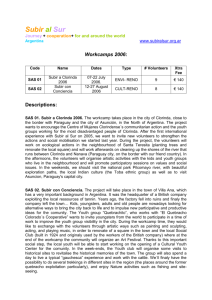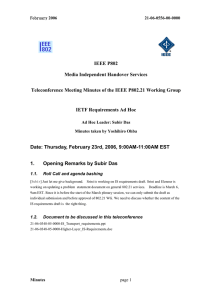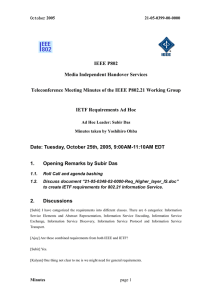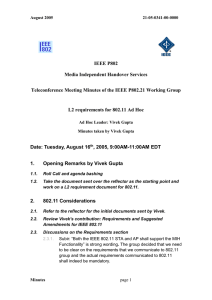IEEE P802 Media Independent Handover Services
advertisement
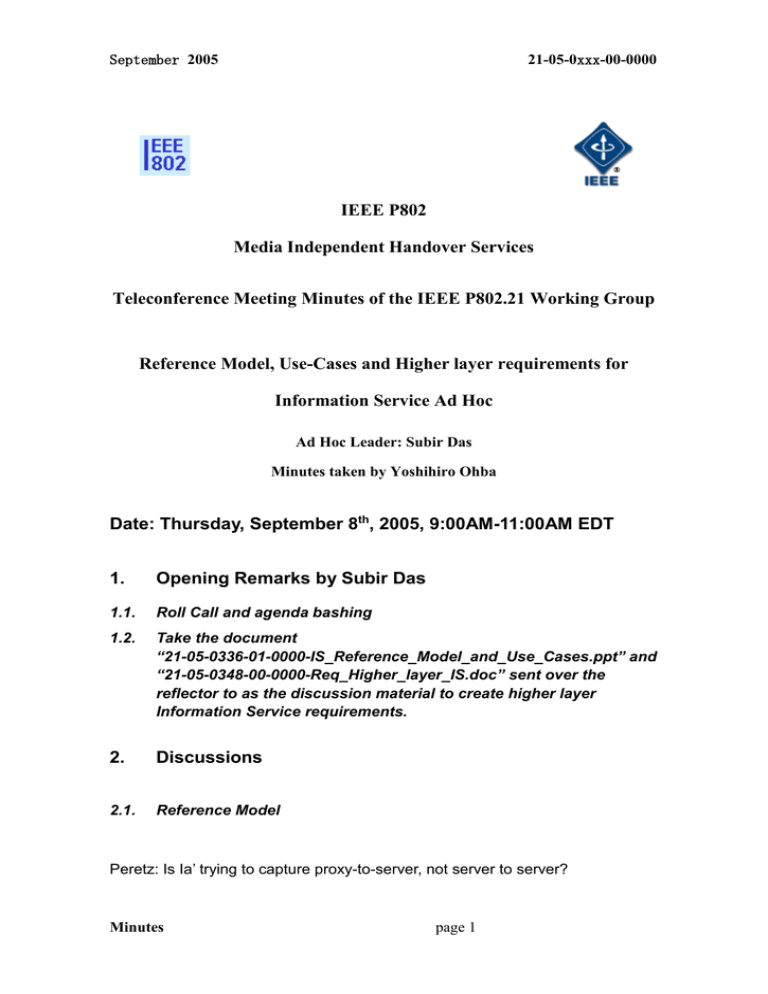
September 2005 21-05-0xxx-00-0000 IEEE P802 Media Independent Handover Services Teleconference Meeting Minutes of the IEEE P802.21 Working Group Reference Model, Use-Cases and Higher layer requirements for Information Service Ad Hoc Ad Hoc Leader: Subir Das Minutes taken by Yoshihiro Ohba Date: Thursday, September 8th, 2005, 9:00AM-11:00AM EDT 1. Opening Remarks by Subir Das 1.1. Roll Call and agenda bashing 1.2. Take the document “21-05-0336-01-0000-IS_Reference_Model_and_Use_Cases.ppt” and “21-05-0348-00-0000-Req_Higher_layer_IS.doc” sent over the reflector to as the discussion material to create higher layer Information Service requirements. 2. Discussions 2.1. Reference Model Peretz: Is Ia’ trying to capture proxy-to-server, not server to server? Minutes page 1 September 2005 21-05-0xxx-00-0000 Subir: Yes. Subir: After the last teleconference, we have reduced the use cases to two. One case is information server co-located with 802.21 IS server, and the other case is information server separate from 802.21 IS server. We explicitly mention that server-to-server communication is out-of-scope. If there are no questions and comments we can move to the higher layer requirements document. 2.2. Higher Layer IS Requirement Subir: Is there any question/comment on Section 1? (none) Subir: Is there any question/comment on Section 2? (none) Subir: Is there any question/comment on Section 3? (none) Section 4. Subir: There is a mixture of higher-layer requirements and generic 802.21 ARE requirements. Req. 4.1: Peretz: Was there any objection about the multi-hop model? Subir: No. Ajay: If that is the proxy model, then it is OK. Peretz: Does Ia imply both L2 and higher layer? Qiaobing: You seem to mention in the beginning of the document that the interface is for L3 or higher-layer. You should stick to that for this discussion and L2 for Ia should be defined in other document. Minutes page 2 September 2005 21-05-0xxx-00-0000 Subir: Yes, you are correct, but since we have mentioned some generic requirements, we should not exclude the L2 aspect as well. Qiaobing: You might consider renaming interface Ia to Ia3, meaning that this interface is L3 and higher. Peretz: Is it not just a difference about the transport? Subir: I’d like to avoid introducing multiple terminologies like Ia3 or Ia2. Let’s concentrate on L3 and above right now and for L2 we will refer some other section. Req. 4.4: Peretz: SAP could be on the terminal. Subir: UE and terminal are the same. Peretz: Are you trying to define a new SAP here? Subir: No. This is a subset of existing 802.21 SAPs. Stefano: What is the use of this document? Subir: This document is to understand and discuss what we need to take to IETF. Stefano: Nothing at all in this document contains requirements for the IETF. Subir: There is a mixture of general requirements and higher layer requirements. We need to identify which particular requirements should be discussed in the IETF. Peretz: It is 21 centric for sure, because it is discussed in 21. Subir: We did not have a clear understanding yet. Stefano: 802.21 has already a requirement document. It is not relevant to have 802.21 requirements in this document. Subir: We do not have to include those requirements in the 802.21 specification, Minutes page 3 September 2005 21-05-0xxx-00-0000 Ajay: In Paris, we questioned the scenarios, requirements and that’s why we are doing this exercise. While you both have points but I think for understanding the IETF requirements we need to go over this exercise. Peretz: Is the requirement document a final one? Ajay: No. It could be second-stage requirement. High-level requirements as the first level and detailed requirements as the second level. Subir’s document is for the former. This should be transparent to IETF. Subir: Through this process, if we can identify some of the requirements and after this step, couple of requirements can be expanded and transformed to IETF requirements. Qiaobing: I agree with both of your views. Ajay: As an action item, rather than identifying everything in one section, pl. put in into two sections, one section contains purely 802.21 requirements and the other section contains IETF requirements. For example, IETF section may be empty at this moment. However, with the time we will try to fill in that bin. Eric: In addition to just defining a protocol on top of a transport, such as TCP, do we need to define primitives, state machines? Subir: That should be a next step. We are identifying basic requirements that may need help from IETF. Stefano: For example, 802.21 cannot define IS server discovery mechanism or security mechanism to secure message exchange. Ajay: We should try to complete this exercise. Let’s put a special section about IETF requirements. Let us discuss which item should be put in the empty bin. Req4.5: Stefano: Why do we need to put a strong language like this in Req. 4.5? Subir: Defining server discovery mechanism is out of scope of 802.21. The 802.21 specification will not define any mechanism for information server discovery. Minutes page 4 September 2005 21-05-0xxx-00-0000 Stefano: OK. Req4.6: Ajay: What is difference between basic set and extended set? Is detailed information is defined in extended set? Or is basic set mandatory supported? Can you give some examples? Subir: Req. 4.6 describes that the basic set is mandatory and extended set is optional. Ajay: Ok, I can understand the difference from a high level. Req. 4.8: Qiaobing: Why IEs need to be related? Subir: It is possible with a flat structure. To make a query we need to know the relationship. Qiaobing: It should be obvious in the definition of IEs. Yoshi: The current basic set IEs do not have relationship among IEs and this is causing a problem. We might need some explicit requirement about relationship. Qiaobing: This is a part of design process. It is a problem of a designer if there is no relationship between IEs. Ajay: Is IE unit sufficient or is hierarchy or chain needed? IEs should have enough definition, for example, as to whose data rate it is. We should determine whether IE unit is sufficient for 802.21 or not. Subir: Both are possible but for flexibility we need the relationship. It needs to be defined either within IE definition or separately. It seems that Req. 4.8 further discussion. Req. 4.9: Subir: This has similar implications as the previous one. Do we need to define only one way of representing information or multiple ways of representing this? Minutes page 5 September 2005 21-05-0xxx-00-0000 Ajay: I prefer one option. Qiaobing: Avoid multiple options if not necessary. Two options in the specification can mean it is a failure. Yoshi: The word representation of IEs is not clear. Does it mean information modeling or information encoding? Subir: Information encoding. Ohba: Information modeling is more important than information encoding. One way of information modeling can lead to multiple ways of encoding schemes. We should have separate requirements on information modeling and information encoding. Subir: We shall revise the requirement and Yoshi has been assigned the responsibility for such revision. Req. 4.10: Ajay: What do you mean by “specify appropriate transport”? Subir: We can change the wording “specify” to “recommend” as suggested by Peretz. Req. 4.11: Subir: We understand Ia and Ia’ have some differences. Peretz: Did we agree Ia nod Ia’ are different? Or are they *may* be different? Subir: At least Ia’ uses higher-layer transport only. Req. 4.12: Stefano: We cannot define security mechanism to secure information service. Subir: Can’t we define in the specification, for example, IPsec SA is needed between UE and server? Stefano: No. Selection of security mechanism should be made by security experts outside our group. Minutes page 6 September 2005 21-05-0xxx-00-0000 Subir: Do you think threat analysis is required for information service? Stefano: Yes and it should done in IETF. Subir: Is there IETF dependency in 21 specifications? Stefano: There will be obvious dependency. Ohba: We might require very high-level requirements something like 802.21 need integrity protection for information query. Stefano: Absolutely, that level of requirements is needed. We can’t define a security solution in .21. Subir: We can discuss this in depth. It is entirely not clear to me what help we need from IETF at this moment. Ajay: I don’t know whether IETF security group does the threat analysis. Stefano: There is on security group to do such work. Security team in MIPSHOP can do it. Req. 4.14: Subir: It is not clear whether .21 need fragmentation or not. It seems in certain cases, we may need fragmentation. Ajay: It is good to categorize the requirements. Subir: Is this an additional section than what you have already mentioned earlier, e.g., IETF requirements and generic requirements? Ajay: Let’s not say IETF requirements, let’s call it transport requirements. Subir: Then we need at least three requirements, general, transport and security. Subir: I don’t like to discuss details about each IE since we had discussed this yesterday telecom. I’d like to request a specific slot for IE discussion and settle on basic IEs in September meeting. Minutes page 7 September 2005 21-05-0xxx-00-0000 Ajay: Some comments on the table. NAT is not a security parameter. It should be a different category. Subir: Yes, we will correct it. 2.3. Next Step Subir: What should be the next step? We will definitely revise the document. What should be the goal of this document? Is it just another exercise? Ajay: Some part of the document can go either in the appendix or initial sections, specifically section 2 and 3. Scenarios should go to the appendix. Ajay: Sending another version of it is a minimum next step. Subir: We shall create a contribution to discuss this in the upcoming meeting. 3. Attendees (More may have attended. Please send updates to Chair) Ajay Rajkumar Eleanor Hepworth Eric Njedjou Mattias Pettersson Peretz Feder Qiaobing Xie Srinivas Sreemanthula Stefano Faccin Stefan Berg Subir Das Vijay Shah Yoshihiro Ohba Minutes page 8
